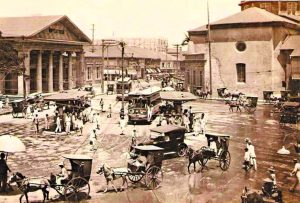Looking back at the history of Manila

Manila is one of the cities that give Filipinos a glimpse of the rich history of the Philippines. From landmarks and structures to narratives and paintings, several accounts can let the people somehow view Manila’s image throughout the years.
Even before the “discovery” of Manila on June 24, 1571, there are already accounts on the look of this historic city.
In 2008, Carmen Guerrero Nakpil recorded the most untold stories on the founding of Manila (referencing also to Tome Pires, Pigafetta, Majul, W.H. Scott, and Gaspar de San Agustin) in her article for Philstar.
As early as the 14th century, the Luzon island natives — composed of traders, investors, mercenaries, seafarers called Luzones — were working in the commerce triangle of Southeast Asia between Canton, Malacca, and Timor. “They owned ships, underwrote large-scale export ventures, and were called “discoverers”, for their sea-faring skills,” Ms. Nakipil wrote.
Manila was the chief city in Luzon. It was ruled by three Muslim kinglets: Ache (or Raha Matanda), a grandson of Sultan Bolkiah of Borneo; Raha Sulayman, Ache’s nephew; and Raha Lakandula of Tondo.
“The town all around this bay was really marvelous. It was tilled and cultivated. The slopes were smooth. So excellent indications have not been seen in this land. The town was situated on the bank of the river, defended by a palisade. Within were many warriors and the shore outside was crowded with many people. Pieces of artillery stood at the gates, guarded by bombardiers, linstock in hand,” stated a Spanish chronicle quoted by O.D. Corpus in The Roots of the Filipino Nation, according to Ms. Nakpil.
After Raha Sulayman routed Martin de Goiti’s attack on Manila in 1570, Spanish conquistador Miguel Lopez de Legazpi, however, arrived and claimed the Spanish sovereignty over Manila in 1571.
Manila then was given “a city charter with municipal councilors, a plan for a plaza, two grand houses and 150 smaller houses, and a project for the distribution of land,” Ms. Nakpil wrote.
That day when Legazpi established a municipal council was recognized now as the foundation day of Manila. Thus, the city commemorated on Araw ng Maynila is the “Spanish Manila.”
In 1952, National Artist for Literature Nick Joaquin put into words an image of Manila of the past, basing on the impression made by an unknown author who traveled in the city around 1860. He said that the watercolors produced by the unknown author have been in the possession of the Zobel family.
“[It is] a Manila of which we have no memory, no knowledge at all. It is terra incognita, newfoundland, a strange unrecognizable place,” Mr. Joaquin, under the pseudonym of Quijano de Manila, wrote in the Philippine Free Press.
“All of us have the same general idea of what is meant by ‘the old Manila, the Spanish Manila.’ We instantly see the sagging balconies of Calle Real, the Gothic spires of Sto. Domingo, the silver Romanesque dome of the Cathedral. Against that unchanging background, we naively pose the conquistadores of the 16th century, the missionaries of the 17th, the grandees of the 18th, and the rebel patriots of the 19th century,” Mr. Joaquin said.

“But now, confronted with these watercolors, we feel like the archaeologists who, searching for the ‘real’ Troy, found seven different Troys, one beneath the other. And we realize how many, many Manilas have come and gone, unknown to us,” he continued.
“In the Manila of these watercolors, nothing is familiar, everything seems ‘wrong’ — Sto. Domingo is not Gothic nor the Cathedral Romanesque; the Governor’s palace stands in the cathedral square, which has an iron fence running around it; San Agustin has two towers; and the Escolta, with its whitewashed one-story buildings, looks like the main street of a minor Andalusian village,” he described.
Mr. Joaquin further considered that though descriptions from historical chronicles could not give a concrete image of the other, earlier appearances of Manila, the unknown artist somehow managed to keep a glimpse of Manila in 1860.
“From the ruins of that other Manila — the odd city smiling at us from the Zobel watercolors — arose the Manila we remember, the Manila of Rizal and the Revolution, the last great creation of Spain in the Philippines,” Mr. Joaquin said.
The city of Manila certainly underwent many changes since that description written by Nick Joaquin. Nevertheless, Manila at present still preserves some of its important historical sites.
The people of Manila will once again commemorate the city’s history, 450 years after its acknowledged foundation on June 24, currently a special holiday in Manila.
For the Araw ng Maynila this year, as posted on Manila City’s official website, Mayor Francisco “Isko Moreno” Domagoso said that “the activities that we have prepared are meant to unite us and be one as we pave the way towards progress and development.”
“With our celebration’s theme of ‘Maynila, Dalhin Mo Ang Bandila,’ we, Manilenyos should be exemplary role models and charge the path for our city to trailblaze and lead the country as we have been doing in the past 449 years,” he added. — Chelsey Keith P. Ignacio



